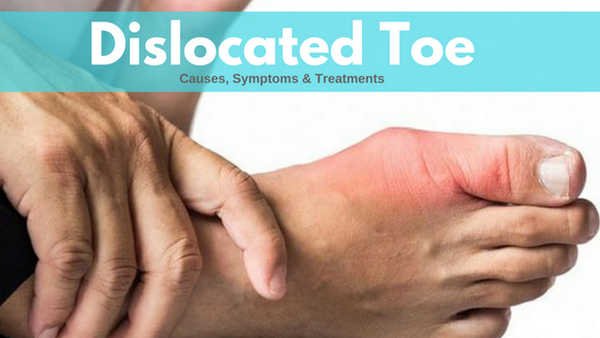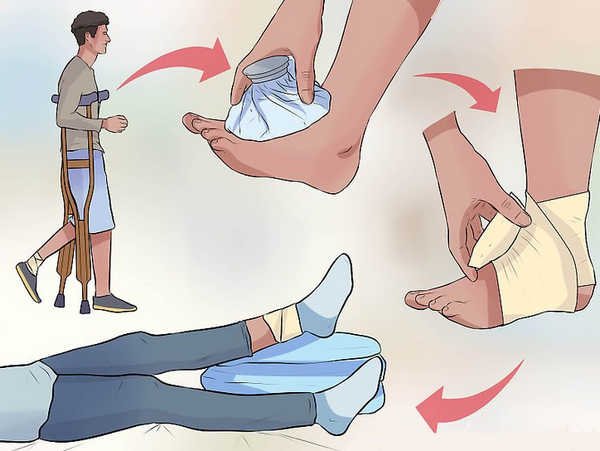How to Fix a Dislocated Toe ?
Toes are tiny body parts that are prone to sprain, dislocation, and breakage. A dislocated toe is when the toe bone moves out of its normal position. A dislocated toe occurs when the ligament that holds the bones in the toe together is torn. A dislocated toe rarely occurs. It only happens when there is a strong blow to the toe. (1, 2, 3)

Image 1: A dislocated toe characterized by redness, swelling, and a bone out of place.
Picture Source: www.paincare.org
Image 3: A patient with a severely dislocated toe.
Picture Source: ncrypted-tbn0.gstatic.com
Photo 4: A patient with multiple dislocated toes.
Picture Source: 3.bp.blogspot.com
Who is prone to having a dislocated toe?
Those who are involved in various sports activities are prone to having a dislocated toe such as soccer players, rugby players, basketball players, dancers, climbers, hikers, and the likes. (2, 3)
Image 5: Those who are involved in sport-related activities are prone to injuries like dislocated toe.
Picture Source: www.trainingcor.com
How do you know if you have a dislocated toe?
How can you tell if your toe is dislocated? What are the signs and symptoms? A dislocated toe is possible is there is a visible misalignment. Most of the time, it is quite difficult to tell if you have a dislocated toe because its symptoms are similar to that of a sprained or a broken toe. The signs and symptoms of a dislocated toe are as follows:
- Visible misalignment/toe bone is visibly out of place
- Intense pain that gets worse when you attempt to move the affected toe
- The toe cannot bear even the slightest pressure
- The affected toe is stiff and hard followed by pale and cool skin indicating that the blood vessels of the affected toe are damaged.
- Swelling and bruising (3, 4, 5)
How to fix a dislocated toe?
What is the best way to fix a dislocated toe? It is something that you can do at home or well it requires a surgical procedure? The treatment approach for a dislocated toe varies depending on the severity of the injury. Ideally, treatment should be given to the patient as soon as possible.
A dislocated toe left untreated can progress to the worst scenario, which requires a more advanced treatment. (6, 7)
How to fix a dislocated toe at home?

Photo 6: A dislocated toe should be treated using the RICE method.
Picture Source: www.wikihow.com

Image 7: A buddy tape is a procedure in which the injured toe is taped to the adjacent toe.
Picture Source: img.webmd.com
First, you need to be certain that the patient has indeed a dislocated toe. Refer to the signs and symptoms mentioned above. If there is indeed a dislocated toe, then you should do the following:
Gentle tug – Gently pop the dislocated toe joint back to its pre-dislocated state. Make sure that you do the procedure right or else you will end up causing further harm. How to do a gentle tug?
- Run your fingers over the injured toe in a pincer position. Make sure that the direction of your fingers is away from your body. Gently partway up the foot and feel for yourself the exact location of the dislocated toe.
- Gently tug the misaligned joint away from the toe (away from the knuckle area) until you hear a snap, which means that the joint is back into its original alignment.
- If you don’t hear a snap, that’s okay. If you reset it correctly, it should be backed to its original alignment.
RICE method – The dislocated toe should be rested, iced, compressed, and elevated. As much as possible, the intense movement should be avoided to avoid causing further harm to the injured toe. To avoid re-injuring the toe, you should splint it or at least try to buddy-wrap the toe to its adjacent toe. (5, 6, 7, 8)
What to keep in mind?
The treatment for a dislocated toe should be carried out within six hours after the toe dislocation. If the dislocated toe has passed the first six hours and no immediate treatment was given to the patient, then the best thing to do is to see a doctor, especially someone specializing in toe-related injury.
Do not attempt to self-adjust way beyond the first six-hour period or else you could end up causing further harm than good. (8, 9, 10)
How long does it take to recover from a dislocated toe?
It would usually take six weeks for the torn ligament to heal. If the injury is severe, the recovery period would take more than six weeks. However, with treatment and proper management and care, the patient’s recovery will be hastened. (3, 5)
Dislocated toe surgery
Photo 8: A case of an open reduction internal fixation of a floppy toe.
Picture Source: faoj.org
A dislocated toe surgery is the last resort. It should only be done if the dislocated toe cannot be positioned properly. The best candidates for dislocated toe surgery are those with a floppy toe. What is a floppy toe? It is a dislocated toe in which the toe is in an awkward position.
It usually occurs after the fracture and the joint becomes unstable, which makes it extremely difficult to align the toe manually. The goal of the surgery is to fix the broken toe in place using wires so that the toe remains in its position while it heals.
The surgical procedure is called open reduction and internal fixation. It is the surgery of choice for dislocated and fractured toe, especially if there are multiple toe fractures. After the surgery, the patient should refrain from doing things that can aggravate the toe.
Depending on the extent of the surgery, it would take six to nine weeks for the patient to completely recover. If the toe has been completely healed, the patient can go back sports and activities without the risk of re-injury. (3, 5, 8, 10)
When should you see a doctor?
- Contact your doctor if the dislocated toe has passed the first six-hour period and no immediate care was given to the patient.
- The pain is extreme that the patient could no longer bear it.
- The patient complains of weakness, tingling sensation, and numbness of the toe. More so, if there is visible discoloration.
- The dislocated toe does not get better even after religious home remedies. (4, 8)
References:
- http://www.sportsinjuryclinic.net/sport-injuries/foot-heel-pain/dislocated-toe-1
- https://myhealth.alberta.ca/Health/aftercareinformation/pages/conditions.aspx?hwid=uh3489
- https://study.com/academy/lesson/dislocated-toes-symptoms-treatment-recovery-time.html
- http://www.thetoedoctor.com/dislocated-toe/
- http://www.tandurust.com/bones-and-joints-disorders/dislocated-toe-how-to-treat-it.html
- http://www.clinic-hq.co.uk/article_46_Dislocated+Toe
- http://www.paincare.org/dislocated-toe/
- http://www.winchesterhospital.org/health-library/article?id=912642
- http://footcare.ygoy.com/2011/12/01/dislocated-toe/
- https://healingfeet.com/foot-care/out-of-place-all-about-dislocated-toes
Published by Dr. Jackie Te RN, MD under Pain Management.
Article was last reviewed on January 12th, 2022.

